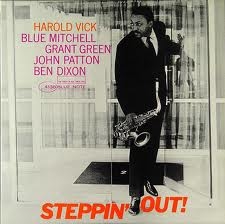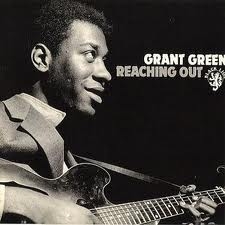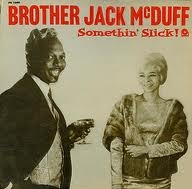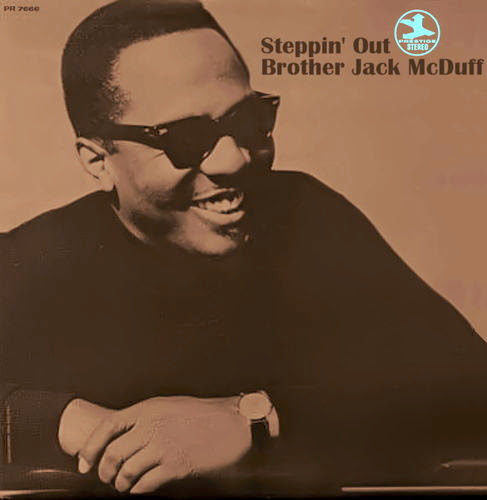Our Miss Brooks – Harold Vick
A groovy blues at any tempo.
- Recording: Harold Vick - Steppin' Out
- Recorded on: May 27, 1963
- Label: Blue Note (BLP 4138)
- Concert Key: G
- Vocal Range: , to
- Style: Swing (groove - medium)
- Trumpet - Blue Mitchell
- Tenor Sax - Harold Vick
- Guitar - Grant Green
- Organ - Big John Patton
- Drums - Ben Dixon
- Description
- Historical Notes
- Solos
- Piano Corner
- Bass Corner
- Drum Corner
- Guitar Corner
- Inside & Beyond
- Minus You
As you'll hear from our audio excerpts from each album, this is a great groove blues that works at a variety of groove tempos. Check it out for yourself—listen to all four clips (one is an alternate from the "Reaching Out" album). The structure is always the same: the first melody chorus ends with an infectious hook that leads into a second melody chorus; the drums then set up the fourth measure re-entrance of the hook, and the second chorus ends with a one measure set up for the solo break. There's also an eight-measure interlude section that sets up the next soloist and the return of the melody.
Normally, we only show clips and discuss tracks that are available as US downloads from iTunes or Amazon. However, Harold's "Steppin' Out" track is not yet available in the US (only in the UK), but it's clearly the way Harold would want the music represented. For that reason our lead sheets come from this track.
Normally, we only show clips and discuss tracks that are available as US downloads from iTunes or Amazon. However, Harold's "Steppin' Out" track is not yet available in the US (only in the UK), but it's clearly the way Harold would want the music represented. For that reason our lead sheets come from this track.
"Steppin' Out" was recorded at the legendary Van Gelder Studio in Englewood Cliffs.
Our Miss Brooks was first released on drummer Dave Bailey's LP "Reaching Out" on the Jazztime label (JT 003), and features the first New York session of California-born tenor saxophonist Frank Haynes. Haynes moved to NYC in 1960, but his career was cut short by cancer, at age 34. The first CD release of that album was under the name of Grant Green as leader, on the Black Lion label.
Composer and tenor saxophonist Harold Vick first recorded this composition himself with organist Jack McDuff four months after the "Reaching Out" recording, but that track remains unreleased. In 1963, Harold recorded his own version on two albums: first, with Jack McDuff for Prestige (early 1963), and then, four months later, on his own Blue Note album "Steppin' Out."
Our Miss Brooks was first released on drummer Dave Bailey's LP "Reaching Out" on the Jazztime label (JT 003), and features the first New York session of California-born tenor saxophonist Frank Haynes. Haynes moved to NYC in 1960, but his career was cut short by cancer, at age 34. The first CD release of that album was under the name of Grant Green as leader, on the Black Lion label.
Composer and tenor saxophonist Harold Vick first recorded this composition himself with organist Jack McDuff four months after the "Reaching Out" recording, but that track remains unreleased. In 1963, Harold recorded his own version on two albums: first, with Jack McDuff for Prestige (early 1963), and then, four months later, on his own Blue Note album "Steppin' Out."
On this Harold Vick penned blues, Green starts out by comping in a supportive, understated fashion, sticking primarily to "Charleston" hits and simple voicings to provide support while avoiding clashes with Big John Patton's comping. However, when Vick's solo ends and Green steps out of the background, he does so in a thrilling fashion, with a greasy, declarative, hemiola-based triplet phrase that undoubtedly "takes house." This type of mid-tempo blues is one of Green's favorite stomping grounds, made evident by his seemingly bottomless pocket and sly, bluesy assertiveness throughout his solo. For any musician who wants to learn something about striking a groove and playing with intention, Green's performance is a true masterclass.
Grant solos 3 blues choruses.
Grant solos 3 blues choruses.
Related Songs
Email Send Our Miss Brooks to a friend
Send this page to a friend via email. Add your name or email in the first field. In the second, add one or more email addresses, separated by a comma.
- Recording: Grant Green - Reaching Out
- Recorded on: March 15, 1961
- Label: Black Lion (BLCD 760129)
- Concert Key: G
- Vocal Range: , to
- Style: Swing (groove - medium slow)
- Tenor Sax - Frank Haynes
- Guitar - Grant Green
- Piano - Billy Gardner
- Bass - Ben Tucker
- Drums - Dave Bailey
0:00
0:00
Buy MP3
Video
- Description
- Historical Notes
- Solos
- Piano Corner
- Bass Corner
- Drum Corner
- Guitar Corner
- Inside & Beyond
- Minus You
Harold Vick was not on the "Reaching Out" takes, so a few things got changed: the chords for the hook going into the second chorus start on the tonic instead of the dominant, and there are other harmonic changes as well.
We're making a C treble clef lead sheet available that shows the alterations made for this recording of Our Miss Brooks, for comparative and analysis purposes. The "Reaching Out" tracks are very sharp in pitch (almost a half step higher). We hope these tracks will someday be adjusted back down to the key of G, rather than sounding like a flat A-flat blues! The main take is take 4 (clip above). The alternate is take 1 tk1
We're making a C treble clef lead sheet available that shows the alterations made for this recording of Our Miss Brooks, for comparative and analysis purposes. The "Reaching Out" tracks are very sharp in pitch (almost a half step higher). We hope these tracks will someday be adjusted back down to the key of G, rather than sounding like a flat A-flat blues! The main take is take 4 (clip above). The alternate is take 1 tk1
Our Miss Brooks was first released on drummer Dave Bailey's LP "Reaching Out" on the Jazztime label (JT 003), and features the first New York session of California-born tenor saxophonist Frank Haynes. Haynes moved to NYC in 1960, but his career was cut short by cancer, at age 34. The first CD release of that album was under the name of Grant Green as leader, on the Black Lion label.
While recorded over two years prior to Vick's rendition on ""Steppin' Out," Green approaches Our Miss Brooks very similarly here, with "Charleston" based comping behind the melody and other soloists and a blues-saturated, rhythmic tongue-twister of a phrase that uncorks a swaggering solo. Of special interest is the slow tempo of the alternate take, which causes Green to dig into the time in an even deeper manner than the brisker takes, and puts his infectious time feel on wide display to the listener.
There are two takes from this session available;
take 1: Grant solos 4 blues choruses
take 4: Grant solos 2 blues choruses
There are two takes from this session available;
take 1: Grant solos 4 blues choruses
take 4: Grant solos 2 blues choruses
Related Songs
Email Send Our Miss Brooks to a friend
Send this page to a friend via email. Add your name or email in the first field. In the second, add one or more email addresses, separated by a comma.
- Recording: Jack McDuff - Something Slick
- Recorded on: January 8, 1963
- Label: Prestige (PRLP 7265)
- Concert Key: G
- Vocal Range: , to
- Style: Swing (groove - medium slow)
- Tenor Sax - Harold Vick
- Guitar - Kenny Burrell
- Organ - Jack McDuff
- Drums - Joe Dukes
0:00
0:00
Buy MP3
Video
- Description
- Historical Notes
- Solos
- Piano Corner
- Bass Corner
- Drum Corner
- Guitar Corner
- Inside & Beyond
- Minus You
Also recorded January 8, 1963, on "Something Slick" / Jack McDuff (Prestige PRLP 7265) [m.m. ca. 122]. Now being sold as from the album "Crash!" This recording is faster than the version on Vick's album "Steppin' Out," but arranged the same way. There are a few more "hits" at the top of Vick's first solo chorus instead of a single long heavy organ chord.
Our Miss Brooks had been recorded by Harold Vick and Jack McDuff a year before this session, on July 14, 1961, during McDuff's "Goodnight, It's Time To Go" session. Guitarist Grant Green played on it, but that take has never been issued. Something about the performance on the January 8, 1963, session must have been more to the producer's liking.
Taken at a quicker tempo than the other recordings featured here (quarter note at ca.124), Jack McDuff's recording of Our Miss Brooks finds Kenny Burrell taking a quite different approach than Grant Green. While Burrell also plays "Charleston" hits behind the melody, his comping behind Vick and McDuff find him both playing a considerable amount of four-to-the-bar rhythm guitar and being noticeably interactive with the soloists. Additionally, Burrell's solo (6 blues choruses) makes serious use of double-stops and chord-soloing in addition to some smokin' single note lines, which frequently burst into double-time or extended strings of triplets. For those interested in Burrell's approach to a mid-tempo blues, his performance here is an excellent one to study.
Composer, tenor saxophonist Harold Vick is the melody instrument, as he was on his own "Steppin' Out" session, so we're recommending looking at that C treble clef lead sheet while checking out this recording.
Composer, tenor saxophonist Harold Vick is the melody instrument, as he was on his own "Steppin' Out" session, so we're recommending looking at that C treble clef lead sheet while checking out this recording.
Related Songs
Email Send Our Miss Brooks to a friend
Send this page to a friend via email. Add your name or email in the first field. In the second, add one or more email addresses, separated by a comma.
- Recording: Jack McDuff - Steppin' Out
- Recorded on: July, 1964
- Label: Prestige (PR 7404)
- Concert Key: G
- Vocal Range: , to
- Style: Swing (groove - medium slow)
- Tenor Sax - Red Holloway
- Organ - Brother Jack McDuff
- Guitar - George Benson
- Drums - Joe Dukes
Video
- Description
- Historical Notes
- Solos
- Piano Corner
- Bass Corner
- Drum Corner
- Guitar Corner
- Inside & Beyond
- Minus You
George Benson with Brother Jack McDuff.
Recorded about halfway through George Benson's tenure with Jack McDuff, his first high-profile gig, Harold Vick's Our Miss Brooks serves as a blistering feature for the precocious (then 21 years old) guitarist.
By this point in time, the McDuff quartet with Benson, Joe Dukes, and Red Holloway was a seasoned and well-oiled unit, having toured and recorded prolifically since June 1963. Indeed, July 1964 also found the quartet recording a big band album in Sweden, which was arranged and conducted by Benny Golson.
Interesting to note is the rhythm section of McDuff and Dukes, who also appear on McDuff's 1963 rendition with Kenny Burrell and Harold Vick.
By this point in time, the McDuff quartet with Benson, Joe Dukes, and Red Holloway was a seasoned and well-oiled unit, having toured and recorded prolifically since June 1963. Indeed, July 1964 also found the quartet recording a big band album in Sweden, which was arranged and conducted by Benny Golson.
Interesting to note is the rhythm section of McDuff and Dukes, who also appear on McDuff's 1963 rendition with Kenny Burrell and Harold Vick.
It's first important to note the ways in which Benson and the rest of the McDuff group play the song differently than Harold Vick. First off, Benson opts to play the second chorus' ending to the melody both choruses. The group also significantly modifies Vick's original hits, adding a figure to the last measure of each melody chorus, starting the hits in the third measure of B on the second triplet of beat 3, and playing a Dsus7 with G in the melody in measures 5 and 6 of the interlude.
Playing the melody to the song, Benson shows off his masterfully dynamic and expressive touch, making use of a variety of techniques (bends, slides, slurs, etc.) and his precise picking to make the phrases pop out in the same way a skilled horn player would play.
When it comes to his solo, Benson lights a veritable fire for the listener, blazing through densely chromatic triple-time phrases and weaving them with moments of the deepest blues. Comping-wise, Benson mostly sticks to the hits laid out by McDuff, making extensive use of tremolo picked chords to mimic the sound of the Hammond organ. However, he also creates a fascinating call-and-response within his playing of "Charleston" hits, often significantly changing the register between the first and second hits to create a chordal conversation with himself.
Guitarists of all levels will find something suitable to study in this performance, from Benson's nuanced and creative approach to comping, to his speech-like articulations and inflections, and to his fearsome linear prowess.
Playing the melody to the song, Benson shows off his masterfully dynamic and expressive touch, making use of a variety of techniques (bends, slides, slurs, etc.) and his precise picking to make the phrases pop out in the same way a skilled horn player would play.
When it comes to his solo, Benson lights a veritable fire for the listener, blazing through densely chromatic triple-time phrases and weaving them with moments of the deepest blues. Comping-wise, Benson mostly sticks to the hits laid out by McDuff, making extensive use of tremolo picked chords to mimic the sound of the Hammond organ. However, he also creates a fascinating call-and-response within his playing of "Charleston" hits, often significantly changing the register between the first and second hits to create a chordal conversation with himself.
Guitarists of all levels will find something suitable to study in this performance, from Benson's nuanced and creative approach to comping, to his speech-like articulations and inflections, and to his fearsome linear prowess.
Related Songs
Email Send Our Miss Brooks to a friend
Send this page to a friend via email. Add your name or email in the first field. In the second, add one or more email addresses, separated by a comma.

Harold Vick
April 3, 1936 – November 13, 1987
Harold Vick is a quintessential example of a great saxophonist and composer who never gained wide public recognition, but was always highly regarded by his fellow musicians. Even jazz legend Sonny Rollins paid compositional tribute to him in 1998 with Did You See Harold Vick? Harold was born in Rocky Mount, North Carolina, which is also the birthplace of Thelonious Monk. At 13, Harold received a clarinet and inspiration from his uncle Prince Robinson, a well-respected clarinetist and tenor saxophonist who played with the likes of Duke Ellington, Roy Eldridge and Louis Armstrong from the 1920s-1950s. Read more...
There was a problem.
...






